
Quebec Cottage Photos
July 16th, 2009
I recently stayed the weekend at a friend's cottage in Quebec, not far from the Gatineau, where I was treated to loon calls on a pristine mountain lake, beautiful but difficult-to-photograph warblers, and other avian treats. Here are some of the pictures I did get:

1680x1050 wallpaper
The lake's resident loon pair. They swam surprisingly close to the dock. Due to the overcast lighting they came out monochrome, but as birds go, Common Loons work better in monochrome than most.
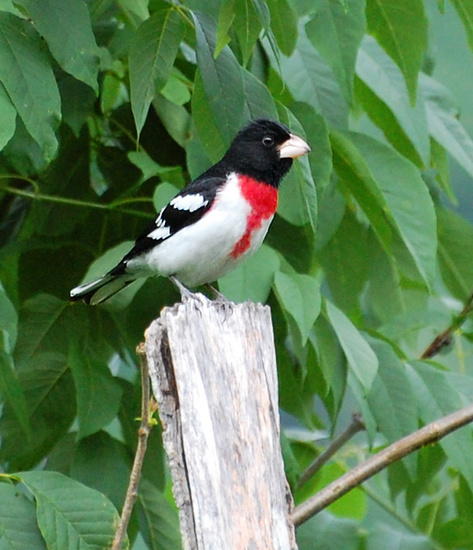
The Rose-Breasted Grosbeak was one of my early thrills as a birder. I saw one in spring migration by the Rideau River in 2007, and he, along with the orioles, was what convinced me to buy binoculars and a field guide. And as with the orioles, it still amazes me that a bird this beautiful breeds in Canada, when it looks like it belongs in the tropics! (In fact Rose-Breasted Grosbeaks do belong in the tropics, roughly eight months out of the year.) This one was actually perched right beside someone's cottage.
My favorite subjects of the weekend were the Common Merganser family, who shared the lake with the loon pair. Unlike with loons, duck fathers usually don't do any child-rearing, so it was just the mother and the ducklings (merglings?) They swam close to shore on my last day. These fish-eating ducks show up each year on Dow's Lake in spring and fall migration, and on the Rideau River in winter, and I'd seen them other times and places as well, but the one way I'd never seen them before is with young!
They were backlit at first...

One or two of the ducklings occasionally rode on their mother's back:

Then they swam into better light.

1680x1050 wallpaper
Adult males look very different from females and young. Here are some photos I posted of them back in March.
Gannet-o-rama
July 12th, 2009
More Northern Gannet pictures from our outing to Bonaventure Island. (First set here, with stories.) These are the last of my Gaspé photos.

1680x1050 wallpaper


1680x1050 wallpaper

1680x1050 wallpaper
( More )
The Auks of Gaspé
July 11th, 2009
Auks are the north-hemisphere analogue to penguins--except that auks can fly, although not too well! Like penguins, their favorite place to be is in the ocean, where they chase after fish underwater. Gaspé peninsula is a great place to see them.
The first three photos are of Black Guillemots, which were the easiest of the auks to photograph. They often swam right next to the pier.
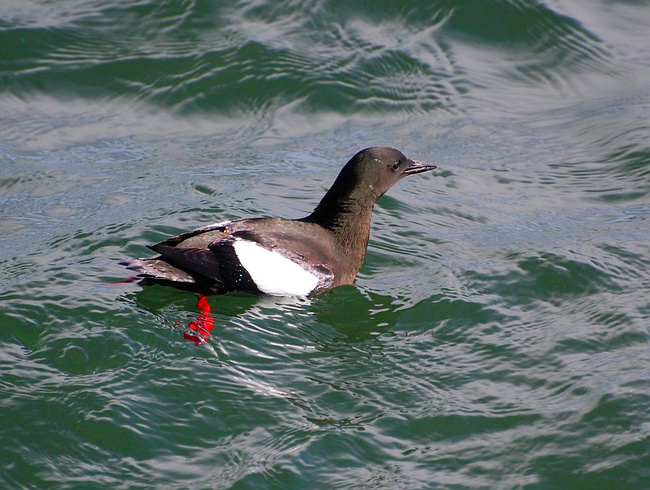
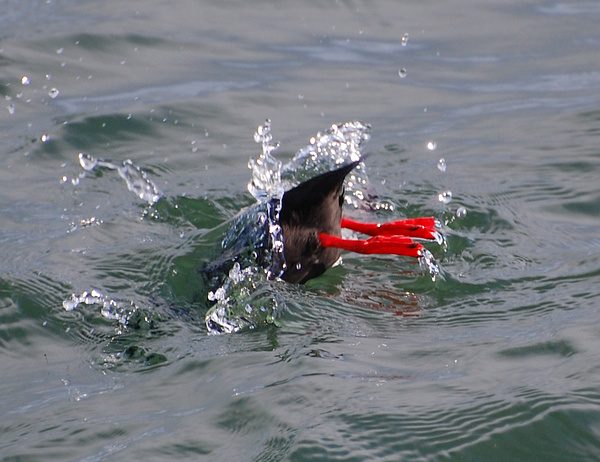
Colors unedited--guillemot feet are quite the feet!

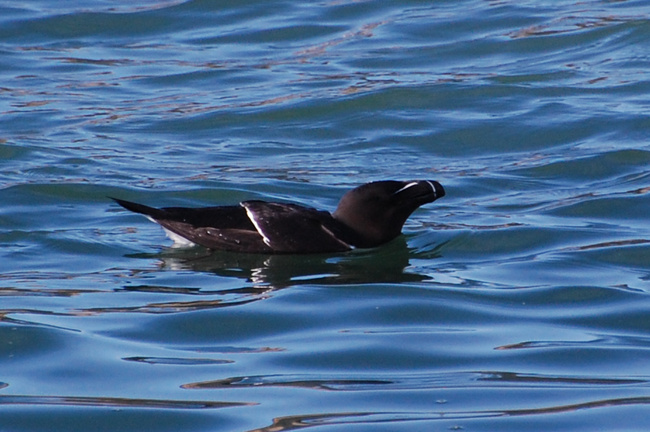
The Razorbills had a habit of catching fish that looked way too big for them, then sitting there, looking around as if to say, "now what?" This one finally flew off with it still flopping in his beak.
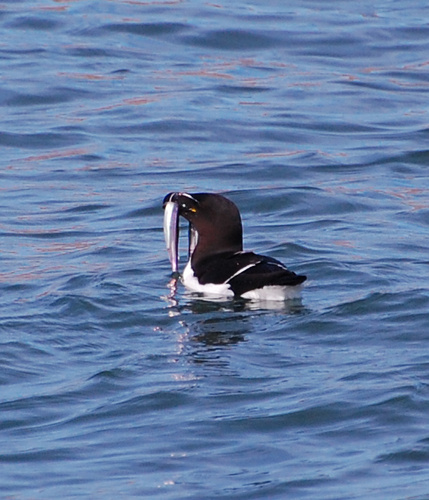
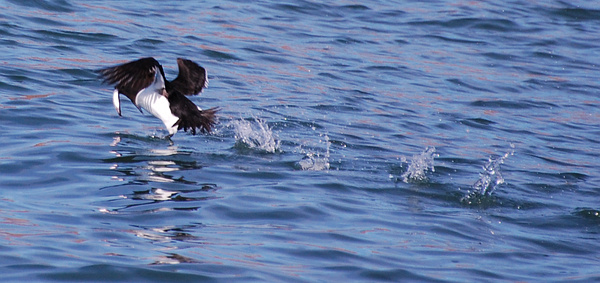
Common Murres were the most difficult of the three auk species to photograph. They never came anywhere near shore. Michael managed to get this one out on open ocean during a whale-watching tour:

The other way to see Common Murres, in abundance, is to find a colony. Generally the only way to do that is by boat, since they breed on sea cliffs. Here's a snapshot. I'm not going to bother providing a thumbnail as really the only way to see them is at full-size--the link is to a 1680x1050 image. You can also see a few nesting kittiwakes in this picture.
Gaspé Miscellanea
July 9th, 2009
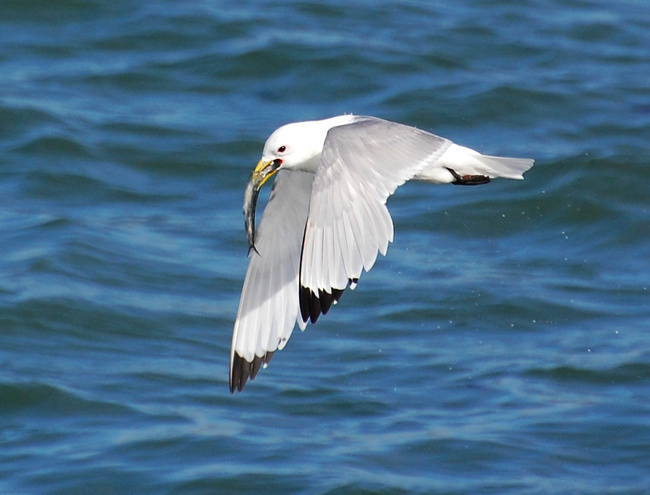
1680x1050 wallpaper
Black-Legged Kittiwake, plus lunch. He had it down within a second of my taking this picture. Kittiwakes are strictly coastal gulls (except for the occasional stray) who nest on cliff ledges. Unlike most gulls who typically pick their food off the surface of the water while floating, kittiwake dive like terns to catch fish.
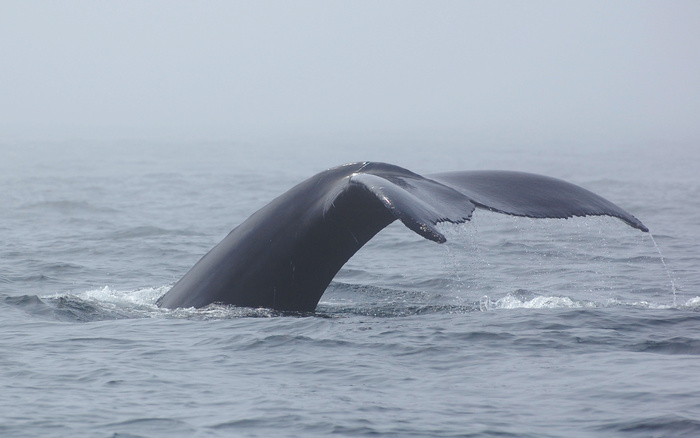
1680x1050 wallpaper
The star of our whale-watching tour, a female Humpback Whale.
nom nom nom OUCH! nom...
July 8th, 2009
In Ottawa, I usually only see Double-Crested Cormorants in migration. In Gaspé they were one of the most common of breeding water birds. I dubbed them "crows of the sea." They could be seen anywhere, anytime offshore, swimming, diving, loafing on small islets, or flying just over the surface of the water.
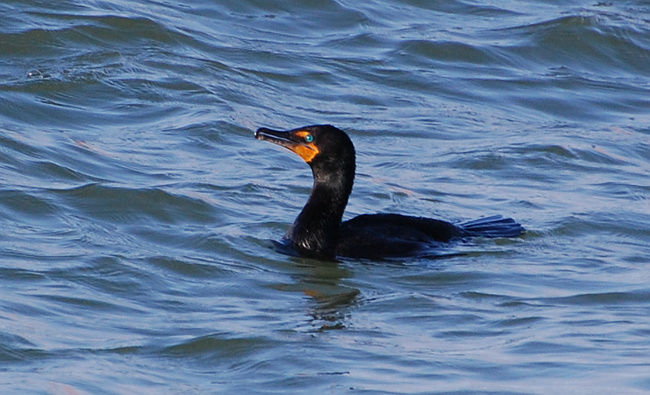
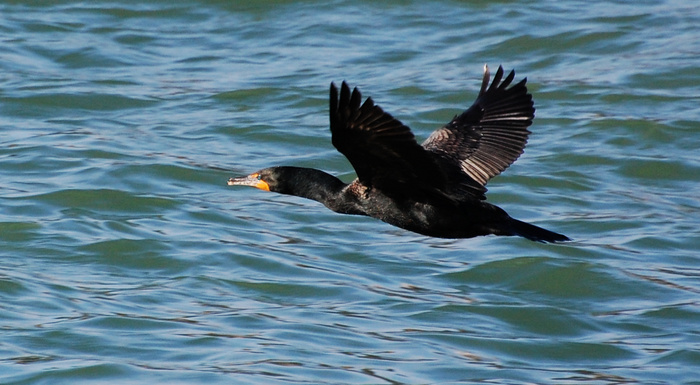

Cormorants are unique. There's really no good way to classify them except as simply "cormorants". When they stand they look like herons. When they show their webbed feet they look like ducks. When they spread their wings in the sun, they look like vultures. Taxonomically, they're most closely related to pelicans. They're one of the few classes of water birds who have non-waterproofed plumage. That helps them stay submerged when they dive, but it also means that, until they dry their wings afterward, they're waterlogged and can barely fly. (In the group photo above, you can see one individual in the classic cormorant wing-drying pose.)
Double-Crested Cormorants sport two fluffy white tufts on their heads during spring courtship, which gives them their name. I've only seen it once myself.
They eat primarily fish, with a side order of crustaceans. Which brings me to this picture and the reason for the title:
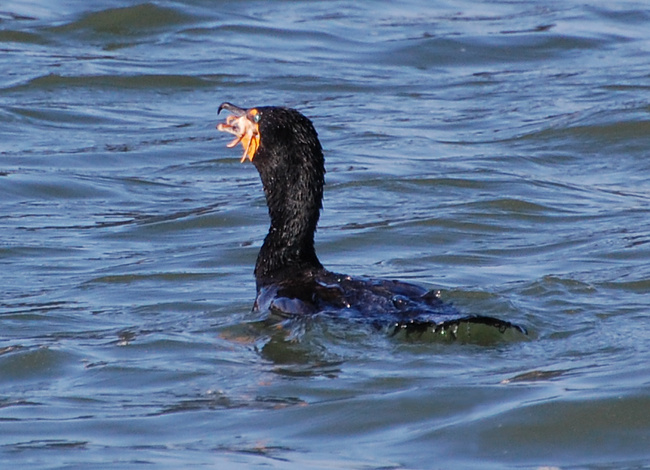
The Lady
July 7th, 2009
A short trail on Mount St. Anne leads to a place called "The Grotto." There's a little natural waterfall and a manmade pool, and a statue of the Virgin Mary, with pennies in one hand and a flower in the other. It's a prayer site. Catholics go there to petition her, or just to find comfort in a quiet, sacred space.
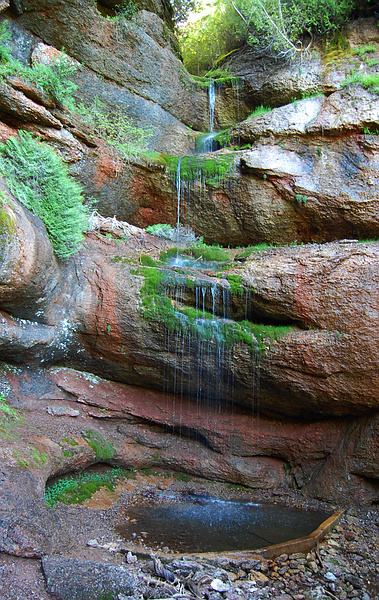
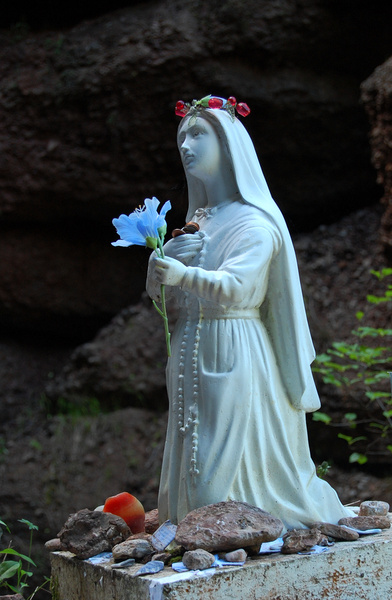
Bonaventure Island Gannet Colony
July 6th, 2009
They were as awesome as I expected.
My first introduction to them was from the pier. They come close to land most days to dive for small fish. Some evenings there were downright spectacular feeding frenzies. I've seen plenty of diving birds in my time, but nothing like this. They fold into a dart shape just before they hit the water, and go in like rockets. The momentum can take them as far as 22 meters under.
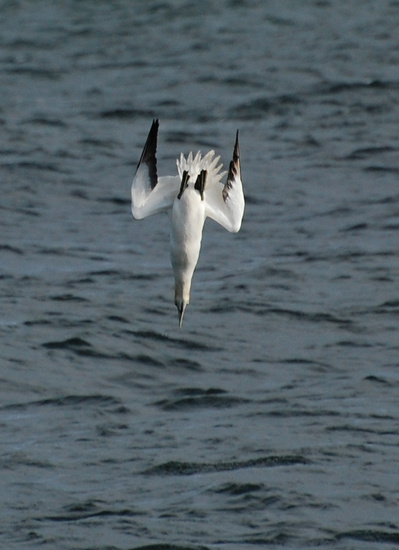
1680x1050 wallpaper
That was exciting, but the pièce de résistance was actually visiting the colony. Tens of thousands of nesting pairs. From the boat, they dot the cliffs as far as your eye can see. From land (after a brief hike) you can see the considerable number of them who actually nest on top of the cliff, and you get a close-up view of courtship and nesting behaviors. Many were already brooding eggs, a few even had newborns. Males continually flew in with hunks of seaweed to line the nests. Others walked to the periphery of the colony to gather sod for the same purpose.
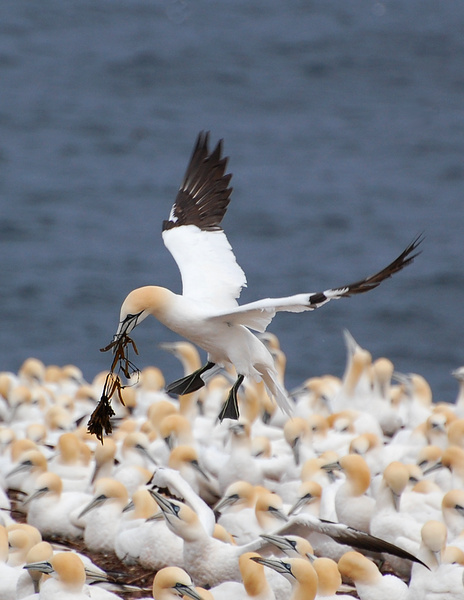
(I think my husband took that one.)
Gannet pairs court and maintain pair bonds by "beak fencing." This is a little different from what the tourist copy might lead you to expect. What you'll read is something like this: "The gannets majestically point skyward and engage in a gentle ritual of tapping beaks." What it actually looks like is more this: one bird points at the sky and starts wagging its head back and forth. The other then does the same thing, and the wagging causes their beaks to tap. Occasionally, one of them will get distracted and start fiddling with something on the ground. The mate continues to wag back and forth by itself, and then the distracted gannet is like, "oh yeah. Right: kissy kissy" and gets back with the program.
They mate for life. Mothers and fathers are both heavily involved in the rearing of young. Both brood, feed and protect their offspring. Males build the nests.
Territorial tiffs were common. Anytime a gannet landed not quite within the invisible boundaries of its (tiny) nesting territory, the gannets in the adjacent nest snapped at it with their beaks.
Around the edges of the colony were the juveniles--young of the last few years--who would not be breeding yet. Instead, they stood alone practicing their skypointing and head-wagging, and probably learning from what they saw in the older birds.
The photographic challenge was, for a change, not finding the bird, nor getting it to come close enough. Those were both easy. The hard part was getting a picture of something other than an undifferentiated mass of gannets. So I sought the stragglers, the oddballs, the ones just flying into and out of the colony or wandering on the periphery.
I have way too many of these to stick into one post. For now, I'll just share two more: the two I'm proudest of.
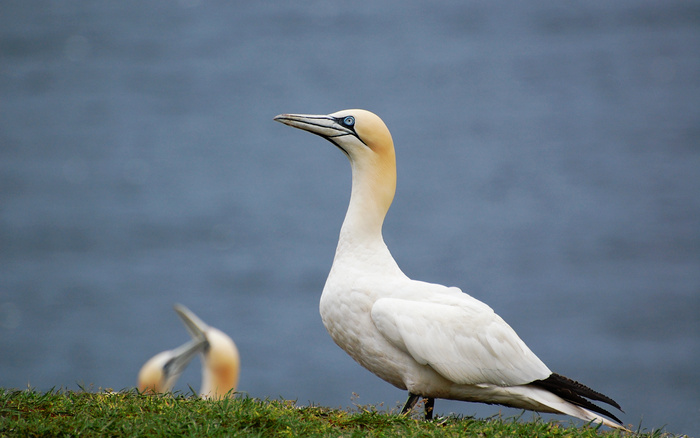
1920x1080 wallpaper
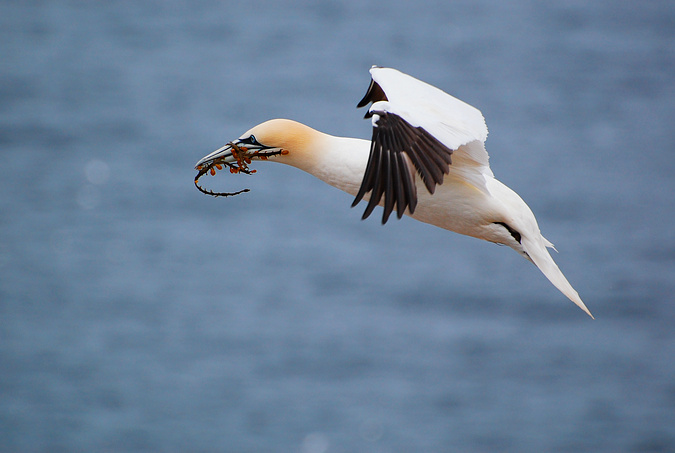
1920x1080 wallpaper
Percé
July 2nd, 2009
The next day we arrived in Percé.
Percé is the smallest town I've ever been to. Not necessarily literally, but that was the feel of it. There was no McDonald's, no Starbucks, no Tim Hortons. No chains of any sort, in fact (except for gas station chains). All, and I mean all of the locals (as well as most of the tourists) were white. All of the locals were francophone. On menus, the same dishes came up over and over again. The fish of choice was cod, and the shellfish of choice was scallops, and the crustacean of choice was lobster. Every restaurant had "cod tongue" on the menu--if there had been a McDonalds, I bet even they would have served cod tongue. (No, we didn't try it.) It felt very much a monoculture, but a friendly monoculture.
Friendly, that is, until you speak English. Speaking English = kiss of death. At least that was my impression, exaggerating only slightly. Over and over I felt the subtle cold shoulder whenever I spoke English, and saw the not-so-subtle warming of people to my husband whenever he revealed his fluent French.
Percé is also the most touristy town I've ever been to. It's positively engrossed in tourism. They have the biggest colony of Northern Gannets in the world right next door, and they have not failed to take notice of this fact. So you can take boat tours every hour on the hour to go see the gannet colony. And there are gannets carved on peoples' fenceposts, and on chairs, and on trash cans. And there are merchants who will happily part you with your money for lovingly crafted ceramic gannets, and gannet t-shirts, mugs, hats, and squeaky toys. It's enough that by the end of a week, you might be expected to feel just a wee bit tired of hearing about gannets, even if you're me.
But you won't.
And if you do, you'll never admit it.
Last but not least, Percé is a beautiful town. It lives in the shadow of the mountains, and at the rocky coast of the north Atlantic. Percé Rock--a huge limestone formation just offshore--makes a good focus for landscape photography.
From the top of Mont Ste-Anne:
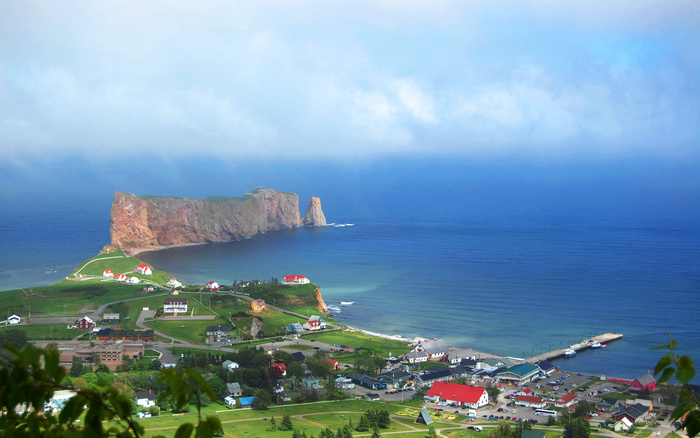
1680x1050 wallpaper
In the category of "wish I lived there":
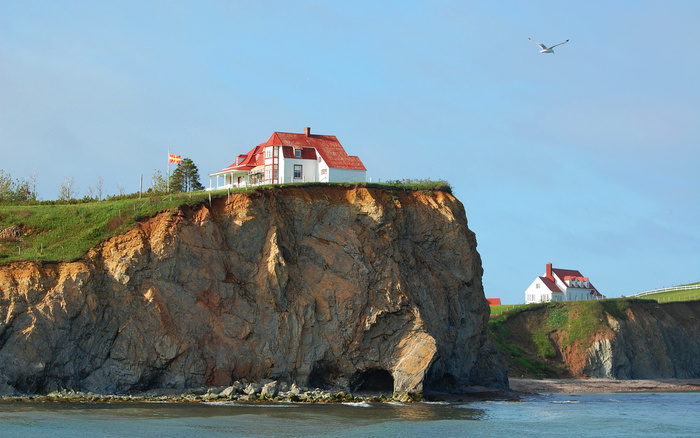
Mike got the next two pictures on one of our few fair days. The first is the tourist pier. Percé Rock is visible at the middle left, Bonaventure Island at the right. The second is the Fleurdelisé, flying proudly over Maison du Pecheur, the best restaurant in town. In an odd and slightly unsettling bit of history, the building that houses Maison du Pecheur was a former hangout for the people who later founded the Quebec Liberation Front.
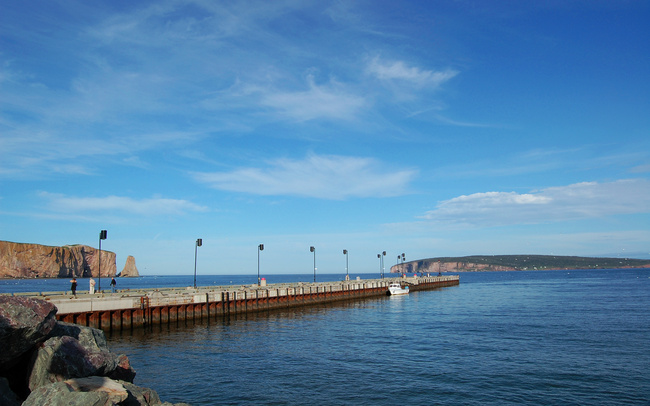

Vacation photos, part 1 of ??
July 1st, 2009
The first thing to talk about is Le Metayer, in L'Isle-Verte (near Riviere-du-Loup). It was, in both our opinions, the best of the four B&B's we stayed at. Warm, relaxed, homey, beautifully furnished. Owners were bird enthusiasts, judging by all the feeders and the field guide sitting on the veranda. Breakfast consisted of eggs cooked to order (they tasted farm fresh) and the best hash browns I've ever had. This was in a very rural area with a faint smell of manure everywhere, but the smell was not overly unpleasant and we quickly got used to it.
It really felt less like a business and more like being welcomed into the home of a new friend (except, of course, for that little paying money part...) They were a retired couple. We got the impression that we were serving as temporary fillers for an empty nest. There were also two cats, one of whom was very long-haired (yet miraculously non-shedding) and very friendly.
Birds, particularly grassland and scrubland birds, were a common sight and sound. Goldfinches frequented the feeders. A pair of Barn Swallows often perched on a line near the house. They must have had a nest nearby, perhaps in the disused shed. (Barn Swallows nest in caves or in things that remind them of caves.) This was a pleasure, as while I can easily see Barn Swallows in Ottawa, I seldom get to see them perched.
Most excitingly, I discovered Bobolinks in the fields between the highway and the St. Lawrence. Bobolinks are grassland birds of the blackbird family. I'd never seen them before. They'd been on my wishlist for years--since I seldom bird rural areas (not having the driver's license needed to get to most rural areas), I've had a hard time spotting even common grassland species. Male bobolinks are handsome and kind of odd-looking, predominately light on top and black on bottom, with a furry cream-colored patch at the back of the head.
The most exciting part was their flight song. They sing a bubbly, exuberant, rather electronic-sounding song (think "chattering R2-D2") while hovering in the air, then drop back down into the grass. 10-15 seconds later the show repeats. This is their approach to catching the ladies' attention. The strategy of many male songbirds is "perch somewhere conspicuous and sing", but in a grassland, such perches are few.
I managed to get a few pictures of them just before we left:
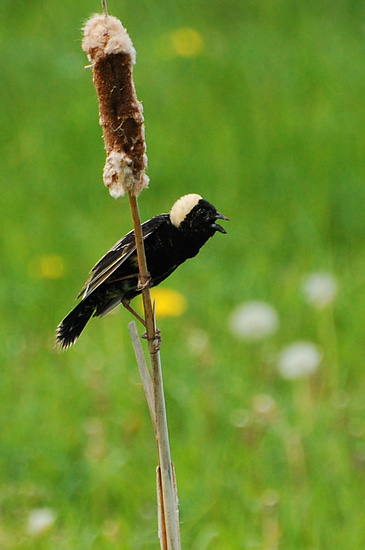
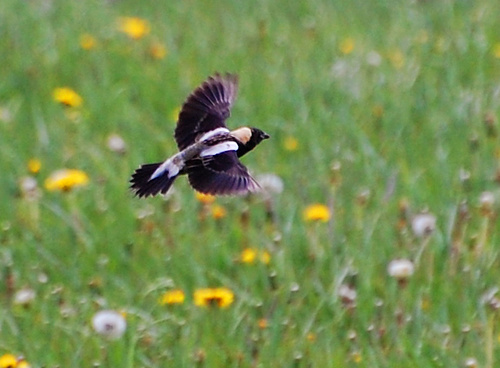
Back from Gaspé with a stop at the Biodome
June 30th, 2009
I've begun wading through my photos, and will start posting them, probably later today.
Our final stop was at the Biodome in Montreal, which made a fitting coup de grace to the vacation. I don't normally like zoos--I don't like seeing animals in cages--but this was different. Entire ecosystems had been recreated indoors. Lots of vegetation, most of which was real, except that the giant trunks in the rainforest area were, I think, stone. In these constructed habitats creatures flew, clambered and swam about in relative freedom. The areas were large and, in many cases, there was no barrier between us and the fauna! (For the lynx pair, however, there was a barrier...) If you've ever played the adventure game Syberia--the train station that had been made into a giant aviary?--that's what it reminded me of.
Lots of exotic birds in the tropical area, along with some small monkeys, a capybara, and some reptiles. There were several Northern Jacanas--pretty chestnut-colored shorebirds with very long toes for walking on lily pads--wading in a stream. A Roseate Spoonbill was perched in a tree. A very tame crested black bird (whose species name I forget, anyone?) was walking underfoot, near a sign that said "I know I'm friendly, but please don't touch me!" And numerous small, colorful songbirds flitted about in the canopy. Challenges were similar to those of real-life in-the-wild bird watching, since they had plenty of foliage to hide in and a wide area to range. Binoculars proved handy.
Much of what I saw I couldn't identify (except with the help of the descriptive plaques, where provided). But a few of the birds--e.g. the jacana and spoonbill--I recognized from my North America field guide, probably because their range just tipped into south Florida, or perhaps in some cases because the North American bird I thought I was seeing had a tropical close relative. Of course, for the purpose of my lifelist, it didn't really matter whether I could identify any of them or not. Birds in captivity are not countable, no matter how well-gilded the cage is!
The birds in the "Laurentian forest" were all species I'd seen, most of them many times, so I didn't linger there (although it was neat to see a Black-Crowned Night Heron so close up!) The "St. Lawrence marine" ecosystem, however, was my favorite part of the Biodome. Here I got to see, up close and personal, many of the seabirds that I had enjoyed on our trip to Gaspé, along with a wonderful assortment of diving ducks (possibly my favorite class of birds). There were Black Guillemots swimming and diving, two Razorbills standing on the rocks, Black-Legged Kittiwakes flying around. There were terns, probably Common Terns; there was a beautiful shorebird I recognized as a Ruddy Turnstone perched on a rock, as well as other shorebirds that I couldn't ID without my field guide.
Of diving ducks, there were: Common Eiders (my god the males are beautiful!), Barrow's Goldeneyes, Long-Tailed Ducks, Harlequin Ducks, Black Scoters, and Buffleheads. I've seen all but two of those (Harlequin, Scoter) before, but only from a distance. No barriers (I wonder if anyone ever gets blitzed by the terns?), and this whole area had a sunroof instead of artificial light. I would have brought my camera if I'd known.
Some of the male ducks appeared to be in or entering into eclipse already. Seemed a bit early to me, but being in captivity may alter the timetable.
The other part of this exhibit allowed us to see the same area underwater, where we were treated to the fascinating sight of underwater Black Guillemots. They dove straight to the bottom and swam around with their wings--a sort of "aquatic flying"--looking for food. But the really neat part was when they came back up. I don't know how they did it, but they actually zoomed up out of the water, like pudgy little torpedos. It happened so fast it was a blur. (Unfortunately, none of the diving ducks went under while I watched, so I didn't get a chance to compare their styles to the guillemots'.)
Finally, we came to fairly small arctic and antarctic sections, where there were Common Murres and King Eiders (arctic) and penguins (antarctic). Not sure why Common Murres were deemed arctic, mind you. There are tens of thousands of them on Bonaventure Island.
In sum: I can't recommend this place highly enough. And don't worry, the line-up is not as bad as it looks. I said a string of "oh my god"s as we tried to find our way to the end of the line, and braced myself for a two-hour wait, but the actual wait was little more than a half hour.
|
